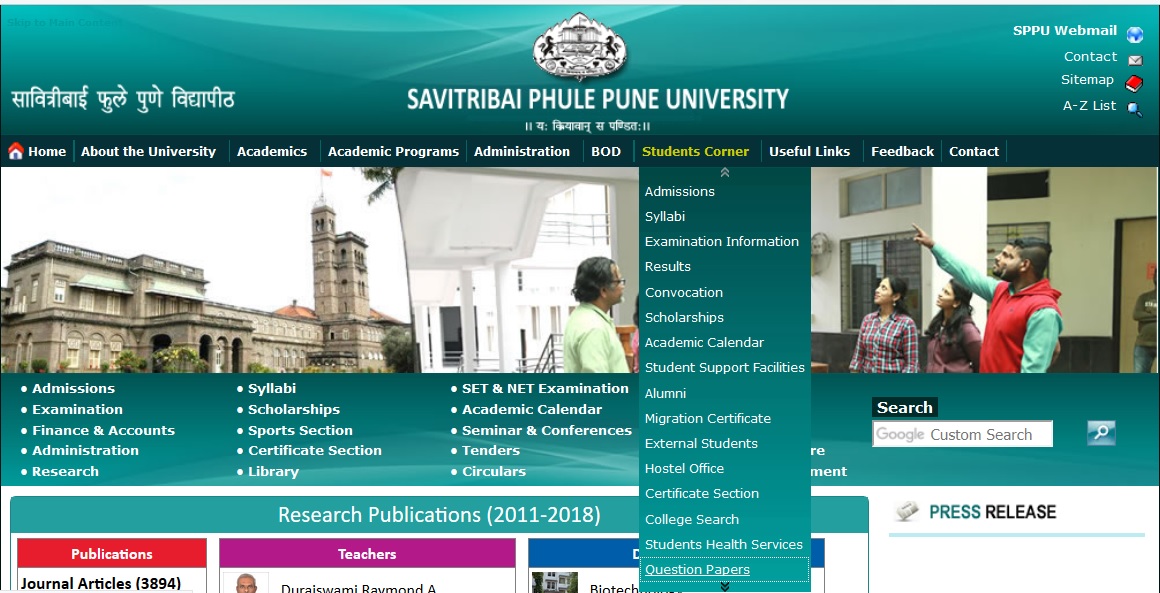unipune.ac.in M.Sc Microbiology Question Paper Model : Savitribai Phule Pune University
Name of the University : Savitribai Phule Pune University
Degree : M.Sc
Name Of The Subject : Microbiology
Document type : Model Question Paper
Website : unipune.ac.in
Download Model Question Papers : https://www.pdfquestion.in/uploads/7516-M.ScMicrobiology.pdf
Pune Microbiology Model Question Paper
Attempt any two of the following : [16]
a) Derive equation for Hill plot and state its significance in relation to allosteric enzymes.
b) Describe the energy generation pathway in sulphate reducing bacteria.
c) Draw pyrimidine nucleus. Schematically draw the pathway leading to its synthesis
Related : Savitribai Phule Pune University Polymer Processing Operations-II B.E Question Paper : www.pdfquestion.in/6998.html
Q2) Attempt any two of the following : [16]
a) How will you calculate free energy change taking place under standard and non standard conditions?
b) Describe the steps recommended by King and Altman to derive kinetic equation for multi-substrate enzyme catalyzed reactions.
c) Illustrate with the help of diagram, structure and function of mitochondrial ATP synthase.
Q3) Attempt any two of the following : [16]
a) What are similarities and differences between ionophores and ion channels?
b) Justify : “One round of Calvin cycle for fixation of six moles of CO2 requires 18 moles ATP and 12 moles NADPH”.
c) Describe biosynthesis of glutamate family amino acids
Q4) Write short notes on any four of the following : [16]
a) Bacteriorhodopsin.
b) Nitrogenase.
c) Entropy.
d) NADH dehydrogenase.
e) Competitive inhibition

Q5) Solve any two of the following : [16]
a) Green sulfur bacteria do not use water as electron donor and do not evolve oxygen upon illumination. Rather they use H2S and evolve elemental sulfur. Given that these photosynthetic organisms use only photosystem I, explain why do they use H2S rather than H2O as an electron donor during the photosynthetic production of NADPH?
b) The oxidation of malate to oxaloacetate in citric acid cycle results in production of 2.5 moles of ATP during oxidative phosphorylation. In contrast, the oxidation of succinate to fumarate in the similar process
produces only 1.5 moles of ATP. Since both oxidations require the transfer two electrons, why should succinate oxidation produce one ATP less?
c) At what substrate concentration would an enzyme with maximum substrate transformation velocity of 30.0 S–1 and Km of 0.005 M operate at one quarter of its maximum rate?
d) Explain in short effect of particle size and particle shape on processing of products by rotational moulding. [4]
e) Discuss the effect of following processing parameters on rotational moulding of liquid polymers. [4]
(i) Rotation speed.
(ii) Shot size.
f) Give any two advantages of rotational moulding of liquid polymers. [2]
Immunology :
Q1) Attempt any two of the following : [16]
a) Compare the immune response of an arthropod with that of a human.
b) Justify “All self reactive lymphocytes are not eliminated in the thymus or bone marrow, yet they are prevented from harming the host”.
c) Explain regulation of immune response by antibody network.
Q2) Attempt any two of the following :
[16]
a) Explain five basic common themes of signal transduction process in case of T-cell activation.
b) Explain the immunoregulatory role of IL-4, INF-g and TNF b in TH subset cells.
c) Justify “Gene rearrangements yield a functional gene encoding the ab T-cell receptor”.
Q3) Attempt any two of the following : [16]
a) Justify, “Intracellular pathogen fail to induce an antibody response”.
b) Explain pathophysiology and diagnosis of chronic granulomatous disease.
c) Explain the etiology and clinical features of Plasma Cell Myeloma
Q4) Attempt any four of the following : [16]
a) Fat body in drosophila.
b) TNF
c) Superantigens.
d) AFP
e) T-cell costimulatory signal (CD 28)
Q5) The antigen activation of T-cell leads to the release or induction of various nuclear factors that stimulate gene transcription. On the basis of given information, answer the following :
a) What transcription factors that support proliferation of activated T-cells
are present in the cytoplasm of resting T-cells in inactive forms?
b) Once in the nucleus, what might these transcription factors do?